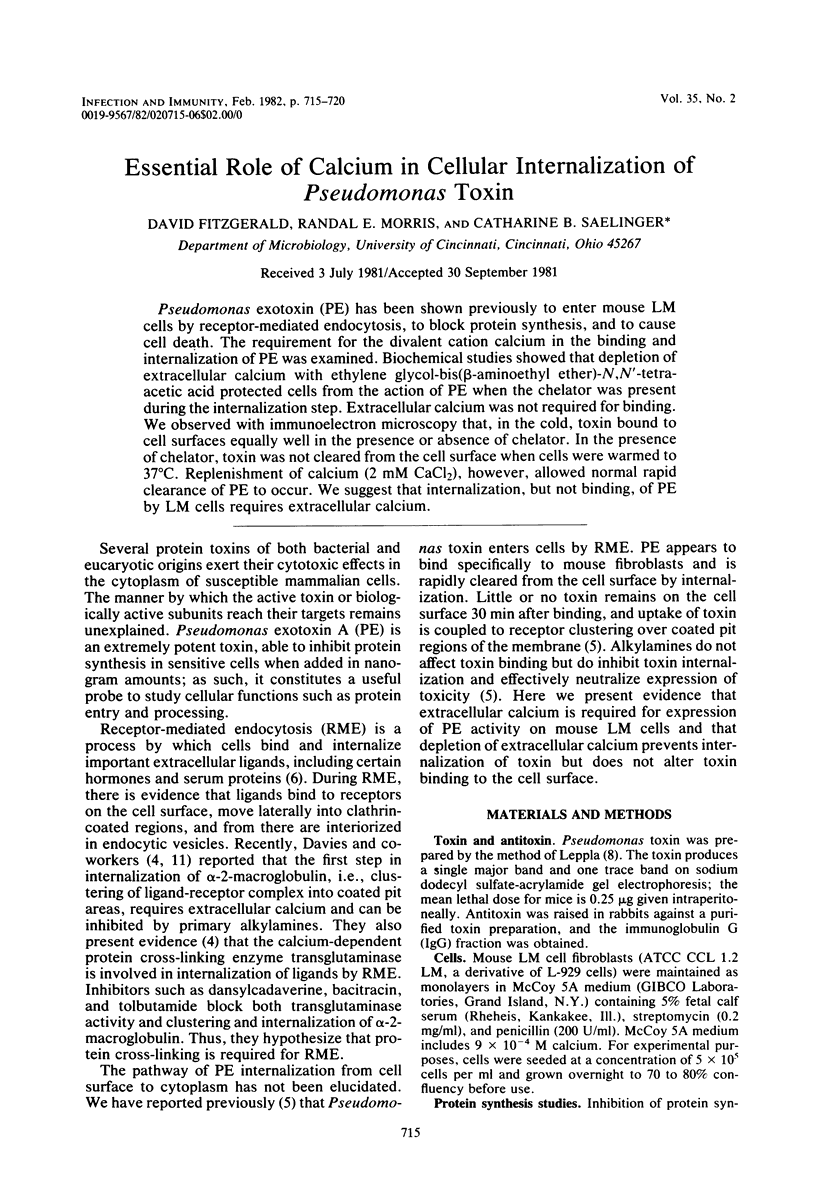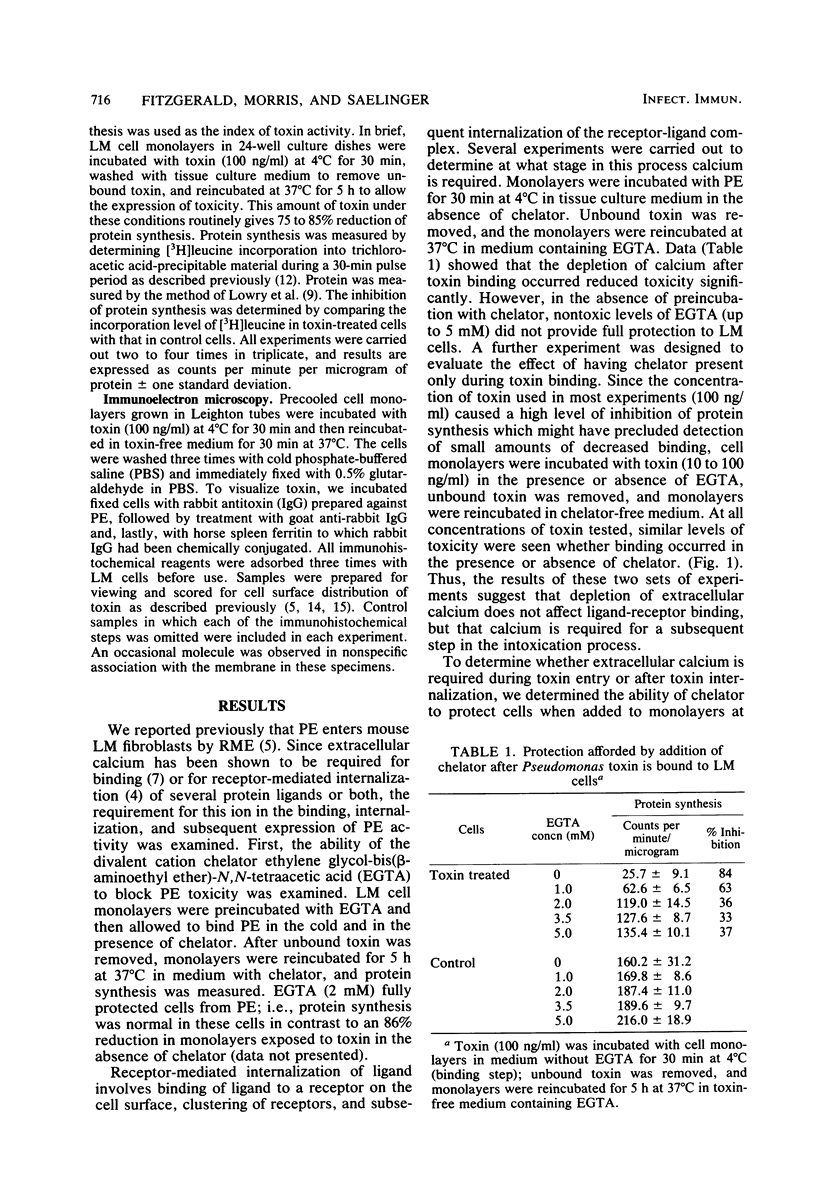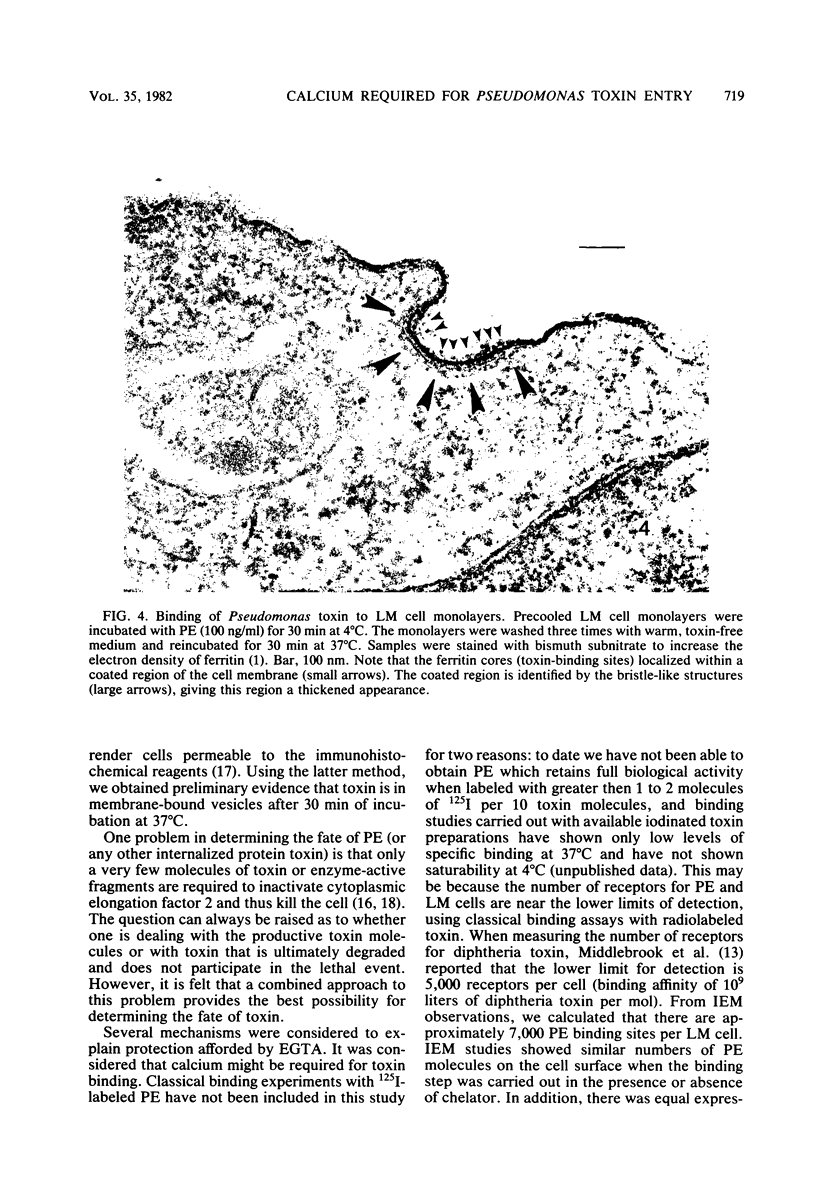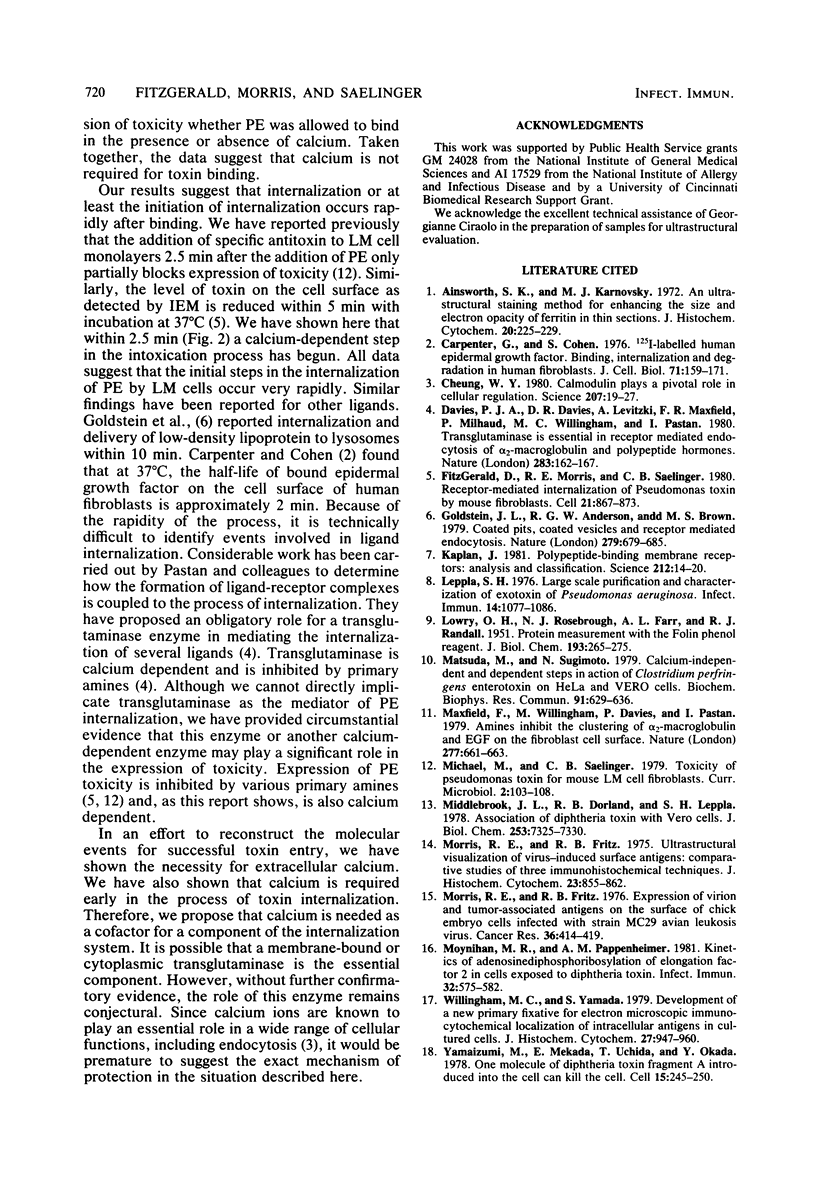Abstract
Pseudomonas exotoxin (PE) has been shown previously to enter mouse LM cells by receptor-mediated endocytosis, to block protein synthesis, and to cause cell death. The requirement for the divalent cation calcium in the binding and internalization of PE was examined. Biochemical studies showed that depletion of extracellular calcium with ethylene glycol-bis(beta-aminoethyl ether)-N,N'-tetraacetic acid protected cells from the action of PE when the chelator was present during the internalization step. Extracellular calcium was not required for binding. We observed with immunoelectron microscopy that, in the cold, toxin bound to cell surfaces equally well in the presence or absence of chelator. In the presence of chelator, toxin was not cleared from the cell surface when cells were warmed to 37 degrees C. Replenishment of calcium (2 mM CaCl2), however, allowed normal rapid clearance of PE to occur. We suggest that internalization, but not binding, of PE by LM cells requires extracellular calcium.
Full text
PDF





Images in this article
Selected References
These references are in PubMed. This may not be the complete list of references from this article.
- Ainsworth S. K., Karnovsky M. J. An ultrastructural staining method for enhancing the size and electron opacity of ferritin in thin sections. J Histochem Cytochem. 1972 Mar;20(3):225–229. doi: 10.1177/20.3.225. [DOI] [PubMed] [Google Scholar]
- Carpenter G., Cohen S. 125I-labeled human epidermal growth factor. Binding, internalization, and degradation in human fibroblasts. J Cell Biol. 1976 Oct;71(1):159–171. doi: 10.1083/jcb.71.1.159. [DOI] [PMC free article] [PubMed] [Google Scholar]
- Cheung W. Y. Calmodulin plays a pivotal role in cellular regulation. Science. 1980 Jan 4;207(4426):19–27. doi: 10.1126/science.6243188. [DOI] [PubMed] [Google Scholar]
- Davies P. J., Davies D. R., Levitzki A., Maxfield F. R., Milhaud P., Willingham M. C., Pastan I. H. Transglutaminase is essential in receptor-mediated endocytosis of alpha 2-macroglobulin and polypeptide hormones. Nature. 1980 Jan 10;283(5743):162–167. doi: 10.1038/283162a0. [DOI] [PubMed] [Google Scholar]
- FitzGerald D., Morris R. E., Saelinger C. B. Receptor-mediated internalization of Pseudomonas toxin by mouse fibroblasts. Cell. 1980 Oct;21(3):867–873. doi: 10.1016/0092-8674(80)90450-x. [DOI] [PubMed] [Google Scholar]
- Goldstein J. L., Anderson R. G., Brown M. S. Coated pits, coated vesicles, and receptor-mediated endocytosis. Nature. 1979 Jun 21;279(5715):679–685. doi: 10.1038/279679a0. [DOI] [PubMed] [Google Scholar]
- Kaplan J. Polypeptide-binding membrane receptors: analysis and classification. Science. 1981 Apr 3;212(4490):14–20. doi: 10.1126/science.6259730. [DOI] [PubMed] [Google Scholar]
- LOWRY O. H., ROSEBROUGH N. J., FARR A. L., RANDALL R. J. Protein measurement with the Folin phenol reagent. J Biol Chem. 1951 Nov;193(1):265–275. [PubMed] [Google Scholar]
- Leppla S. H. Large-scale purification and characterization of the exotoxin of Pseudomonas aeruginosa. Infect Immun. 1976 Oct;14(4):1077–1086. doi: 10.1128/iai.14.4.1077-1086.1976. [DOI] [PMC free article] [PubMed] [Google Scholar]
- Matsuda M., Sugimoto N. Calcium-independent and dependent steps in action of Clostridium perfringens enterotoxin on HeLa and Vero cells. Biochem Biophys Res Commun. 1979 Nov 28;91(2):629–636. doi: 10.1016/0006-291x(79)91568-7. [DOI] [PubMed] [Google Scholar]
- Maxfield F. R., Willingham M. C., Davies P. J., Pastan I. Amines inhibit the clustering of alpha2-macroglobulin and EGF on the fibroblast cell surface. Nature. 1979 Feb 22;277(5698):661–663. doi: 10.1038/277661a0. [DOI] [PubMed] [Google Scholar]
- Middlebrook J. L., Dorland R. B., Leppla S. H. Association of diphtheria toxin with Vero cells. Demonstration of a receptor. J Biol Chem. 1978 Oct 25;253(20):7325–7330. [PubMed] [Google Scholar]
- Morris R. E., Fritz R. B. Expression of virion and tumor-specific antigens on the surface of chick embryo cells infected with strain MC29 avian leukosis virus. Cancer Res. 1976 Feb;36(2 Pt 1):414–419. [PubMed] [Google Scholar]
- Morris R. E., Fritz R. B. Ultrastructural visualization of virus-induced surface antigens. Comparative studies of three immunohistochemical techniques. J Histochem Cytochem. 1975 Nov;23(11):855–862. doi: 10.1177/23.11.172555. [DOI] [PubMed] [Google Scholar]
- Moynihan M. R., Pappenheimer A. M., Jr Kinetics of adenosinediphosphoribosylation of elongation factor 2 in cells exposed to diphtheria toxin. Infect Immun. 1981 May;32(2):575–582. doi: 10.1128/iai.32.2.575-582.1981. [DOI] [PMC free article] [PubMed] [Google Scholar]
- Willingham M. C., Yamada S. S. Development of a new primary fixative for electron microscopic immunocytochemical localization of intracellular antigens in cultured cells. J Histochem Cytochem. 1979 May;27(5):947–960. doi: 10.1177/27.5.90071. [DOI] [PubMed] [Google Scholar]
- Yamaizumi M., Mekada E., Uchida T., Okada Y. One molecule of diphtheria toxin fragment A introduced into a cell can kill the cell. Cell. 1978 Sep;15(1):245–250. doi: 10.1016/0092-8674(78)90099-5. [DOI] [PubMed] [Google Scholar]



